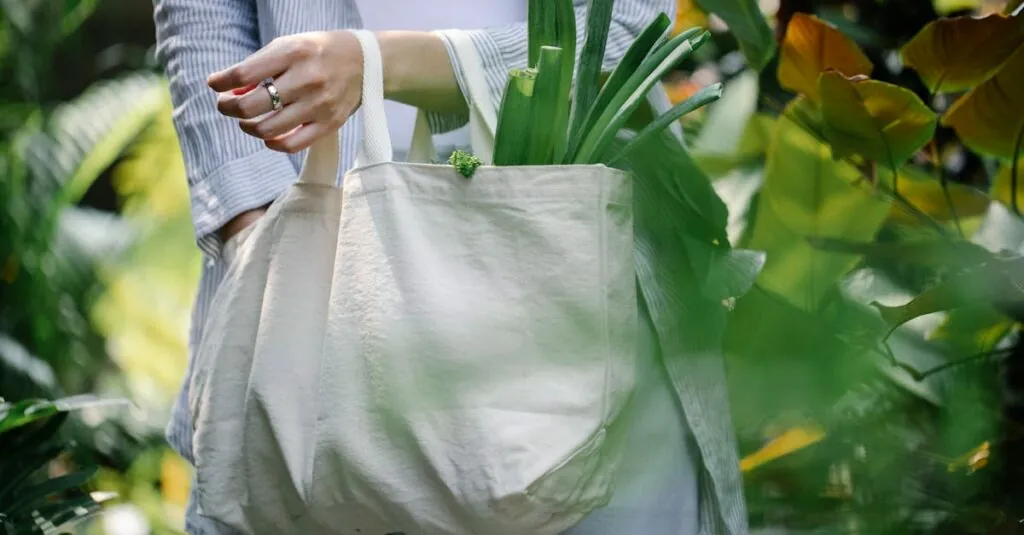Table of Contents
ToggleAs summer 2024 approaches, the fashion world is buzzing with fresh ideas that aren’t just stylish but also eco-friendly. Gone are the days when sustainable fashion meant sacrificing style for ethics. This season, it’s all about vibrant colors, innovative materials, and designs that make Mother Nature proud.
Imagine strutting down the street in a chic outfit made from recycled ocean plastics or organic cotton that feels as good as it looks. The latest trends promise to turn heads while keeping the planet happy. From playful prints to minimalist silhouettes, these styles are perfect for anyone looking to make a statement—without leaving a carbon footprint. Get ready to dive into the world of sustainable fashion and discover how to look fabulous while being environmentally conscious. Who knew saving the planet could be this stylish?
Overview of Sustainable Fashion
Sustainable fashion focuses on environmentally friendly practices in the clothing and accessory industry. Many brands are now prioritizing eco-conscious materials and ethical production methods. Fabrics such as recycled polyester, organic cotton, and Tencel are gaining popularity. These materials reduce environmental impact while maintaining high quality.
The rise of slow fashion promotes the idea of timeless styles over fast trends. Consumers are encouraged to invest in versatile pieces that withstand the test of time. This shift in mindset minimizes waste and promotes thoughtful purchasing decisions.
Innovative production techniques, like 3D knitting and zero-waste pattern making, also contribute to sustainability. These methods reduce fabric waste, creating garments that align with eco-friendly values. Some brands are even utilizing biodegradable fibers, allowing clothes to decompose at the end of their lifecycle.
Transparency in supply chains has become a significant trend. Many consumers demand to know the origin of their garments and the practices used in production. This expectation drives brands to showcase their sustainability efforts, helping consumers make informed choices.
Furthermore, circular fashion is emerging as a key concept, promoting recycling and upcycling initiatives. Programs that encourage customers to return used clothing for recycling enhance sustainability. This proactive approach allows brands to minimize landfill waste while creating new products from old materials.
Supporting local artisans is another aspect of sustainable fashion. Many designers collaborate with regional craftspeople to produce unique, ethically made products. These partnerships not only celebrate cultural heritage but strengthen local economies.
Overall, sustainable fashion encompasses various practices and ideologies focused on protecting the environment while delivering stylish options. Embracing these trends contributes to a more sustainable future for the fashion industry.
Key Trends for Summer 2024
Sustainable fashion is rapidly evolving, with innovative trends shaping the summer 2024 season. Designers increasingly focus on eco-friendly practices and materials, enabling consumers to make environmentally conscious choices.
Eco-Friendly Materials
Innovative textiles dominate the summer collection. Organic cotton remains a favorite due to its minimal environmental impact and comfort. Recycled polyester offers durability, made from plastic bottles and discarded fabrics. Tencel, derived from sustainably sourced wood pulp, provides a soft, biodegradable alternative. Designers also experiment with biodegradable denim and innovative plant-based fibers, such as hemp and linen. These materials not only reduce waste but also maintain high-quality standards, making them appealing to consumers.
Upcycling and Vintage Resurgence
Upcycling takes center stage as brands transform old garments into stylish new pieces. This trend encourages creativity while extending the life of clothing items. Vintage styles see a resurgence, appealing to those who appreciate unique fashion. Thrift shops and online resale platforms gain popularity, allowing consumers to discover one-of-a-kind finds. Many fashion labels collaborate with vintage specialists, reimagining classic designs for modern wear. This movement not only promotes sustainability but also celebrates personal style, blending the past with contemporary trends.
Influential Designers and Brands
Sustainable fashion trends for summer 2024 see innovative designers and brands shaping the landscape. These industry leaders incorporate eco-friendly practices while crafting stylish pieces.
Leading the Change
Stella McCartney stands at the forefront of sustainable fashion. Her collections emphasize organic materials and cruelty-free practices. Brands like Reformation make strides by using recycled fabrics and promoting circularity in their designs. They inspire consumers with their commitment to transparency in supply chains. Another notable mention is Patagonia, renowned for its environmental activism and responsible sourcing initiatives. Collective efforts from these designers influence a broader shift towards sustainable practices within the fashion industry.
Collaborative Collections
Collaborations create impactful statements in sustainable fashion. Brands such as Adidas partner with Parley for the Oceans, transforming ocean plastic into stylish athletic wear. High-profile collaborations like H&M’s Conscious Collection highlight eco-conscious designs accessible to a wider audience. Similarly, the collaboration between Vogue and the CFDA showcases emerging sustainable designers, elevating their voices in the marketplace. Such partnerships foster innovation and creativity, pushing the boundaries of traditional fashion while prioritizing sustainability.
Consumer Behavior Shifts
Environmental awareness drives consumer choices in summer 2024. Shoppers prioritize sustainability by seeking eco-friendly brands. Many prefer garments made from organic cotton and recycled materials due to their reduced environmental impact. A desire for transparency has emerged; consumers want to understand the origins of their clothing.
In this evolving market, the importance of slow fashion gains recognition. Investing in timeless, versatile pieces proves attractive as consumers move away from fast fashion trends. By choosing quality over quantity, shoppers contribute to waste reduction and cultivate a more sustainable wardrobe.
Brands recognize the shift and adapt their strategies. Collaboration with local artisans reflects growing consumer interest in cultural heritage and craftsmanship. Such partnerships not only support local economies but also enhance the authenticity of fashion products.
Online resale platforms gain traction as shoppers embrace second-hand shopping. Vintage styles hit the spotlight, appealing to consumers’ appreciation for unique and sustainable options. Thrift shops also experience renewed interest, allowing individuals to find distinctive pieces while minimizing landfill waste.
Many designers and brands play pivotal roles in shaping these consumer behaviors. Companies like Stella McCartney and Reformation engage eco-conscious customers with stylish collections. Innovative initiatives, such as Adidas’s collaboration with Parley for the Oceans, showcase how sustainability can merge seamlessly with high fashion.
Ultimately, these consumer behavior shifts highlight a crucial trend in summer 2024. The fashion industry witnesses a transformation driven by demand for eco-friendly choices. As awareness of environmental issues grows, so too does the commitment to sustainable fashion practices.
Future of Sustainable Fashion
Emerging trends indicate a strong focus on circular fashion, wherein brands prioritize recycling and upcycling. Consumers increasingly choose garments that can be repurposed, reducing landfill waste. Moreover, technological advancements in sustainable materials play a crucial role. Innovations such as biodegradable textiles and plant-based fabrics like mushroom leather offer alternatives to conventional materials.
Transparency in supply chains continues to gain momentum. Companies now openly disclose production practices, enhancing consumer trust. Designers aim to connect with eco-conscious buyers by showcasing responsible sourcing methods. Collaborative efforts among brands further amplify this movement. Partnerships between major labels and local artisans celebrate craftsmanship while fostering economic growth in communities.
Sustainable fashion is also characterized by unique designs that blend style with ethics. Influential designers are introducing eco-friendly collections that reflect vibrant aesthetics without compromising environmental principles. For instance, collections featuring recycled ocean plastics illustrate the combination of innovation and sustainability.
Shifts in consumer behavior reinforce this landscape’s evolution. Buyers prioritize sustainability in their purchasing decisions, prompting brands to adapt their offerings. Traditional fast-fashion practices decline as demand for seasonal trends dwindles. Instead, shoppers seek versatile, timeless pieces that align with eco-friendly values.
Current industry practices emphasize minimal waste and responsible consumption. Emerging brands focus on slow fashion, encouraging investments in high-quality, long-lasting garments. Online resale markets and thrift shopping continually rise as consumers search for unique finds, contributing to a more sustainable fashion ecosystem.
Summer 2024 promises a landscape filled with exciting innovations in eco-fashion. A commitment to sustainability emerges not just as a trend but as a fundamental ethos in the industry. Designers and consumers alike embrace this evolution, collectively shaping the future of sustainable fashion.
Summer 2024 is set to redefine sustainable fashion with a vibrant blend of style and ethics. As designers embrace eco-friendly materials and innovative practices, consumers are empowered to make conscious choices that reflect their values. The rise of circular fashion and transparency in supply chains signifies a shift towards a more responsible industry.
With brands prioritizing timeless pieces and unique designs, shoppers can enjoy fashion that not only looks good but also does good. By supporting sustainable practices, individuals contribute to a positive change in the fashion landscape. The future is bright for eco-fashion enthusiasts as they navigate a world where style meets sustainability.




